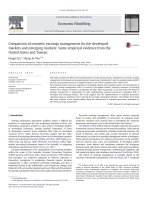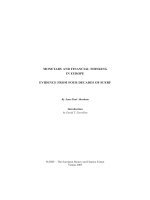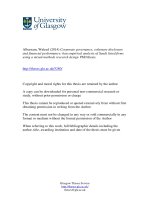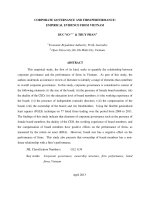pari chalaki - 2012 - corporate governance attributes and financial reporting quality - empirical evidence from iran
Bạn đang xem bản rút gọn của tài liệu. Xem và tải ngay bản đầy đủ của tài liệu tại đây (199.94 KB, 7 trang )
International Journal of Business and Social Science Vol. 3 No. 15; August 2012
223
Corporate Governance Attributes and Financial Reporting Quality: Empirical
Evidence from Iran
Pari Chalaki
Department of Accounting
Urmia University
Iran
Hamzeh Didar
Department of Accounting
Urmia University
Iran
Mohadeseh Riahinezhad
M.A. student in Accounting
Urmia University
Iran
Abstract
The aim of this study is to investigate the effect of corporate governance attributes on financial reporting quality
in firms listed in Tehran Stock Exchange (TSE) during the period of 2003 to 2011. In this study McNichols (2002)
and Collins and Kothari (1989) are used for financial reporting quality measurement purpose, and institutional
ownership, ownership concentration, board independence and board size is considered as corporate governance
attributes. The results of the study show that there is no relationship between corporate governance attributes
including board size, board independence, ownership concentration, institutional ownership and financial
reporting quality. In addition, no evidence is found to support significant relationship between control variables
(audit size, firm size and firm age) and financial reporting quality.
Keywords: Corporate governance attributes, financial reporting quality
Introduction
Financial reporting quality is a major concern for all current and potential investors. According to Biddle et al.
(2009) financial reporting quality is defined as the precision with which financial reporting conveys information
about the firm’s operations, in particular its expected cash flows that inform equity investors. Their definition is
consistent with the Financial Accounting Standards Board Statement of Financial Accounting Concepts No. 1
(1978), which states that one objective of financial reporting is to inform present and potential investors in
making rational investment decisions and in assessing the expected firm cash flows. Corporate scandals of the last
decade and collapse of big firms in recent years raised concerns about financial reporting quality which led to the
passage of Sarbanes–Oxley which had a focus on the financial aspects of corporate governance. Requiring
independent directors, more autonomy of the audit committee and the appearance of more accountability by the
chief executive officer (CEO) and the chief financial officer (CFO) were all elements of this corporate governance
focus (Cong and Freedman, 2011). DeFond and Lennox (2011) find that the passage of SOX results in a large
reduction in the number of small audit firms operating in the market.
They report that nearly 50%, 607 of 1,233 small audit firms that were active during 2001–2008 exited the market
and the majority of these exits occur in 2002–2004, coinciding with passage of SOX, the advent of PCAOB
registrations, and the beginning of inspections. The presence of fewer small auditors coincides with a doubling of
the average number of clients per small audit firm.
© Centre for Promoting Ideas, USA www.ijbssnet.com
224
Low quality auditors are more likely to be cost beneficial, at the margin, to exit the market for public company
audits in response to the new regulatory environment implemented under SOX (P.22). These results show that the
passage of these Acts increased audit quality if audit size supposed to be proxy for audit quality. Moreover, it is
expected that high audit quality lead to high financial reporting quality. Therefore, the passage of Acts led to
increase financial reporting quality. However, good governance practices (including auditing) are value
enhancing. A firm with a set of effective governance controls that lowers the conflict of interests between
minority shareholders and insiders tends to increase its firm value by reducing information asymmetry and
increasing management efficiency (Lee et al., 2011). Researchers often view corporate governance mechanisms as
falling into one of two groups: those internal to firms and those external to firms (Gillan, 2006:382).
Internal
Assets
Debt
Equity
External
Fig. 1. Corporate governance and the balance sheet model of the firm. Adapted from PowerPoint slides
accompanying Ross et al. (2005).
The left-hand side of the diagram comprises the basics of internal governance. Management, acting as
shareholders’ agents, decides in which assets to invest, and how to finance those investments. The Board of
Directors, at the apex of internal control systems, is charged with advising and monitoring management and has
the responsibility to hire, fire, and compensate the senior management team. The right-hand side of the diagram
introduces elements of external governance arising from firm’s need to raise capital. Further, it highlights that in
the publicly traded firm, a separation exists between capital providers and those who manage the capital. This
separation creates the demand for corporate governance structures (reported from Gillan (2006:382)).
Literature review
Chen et al. (2006) examined whether ownership structure and boardroom characteristics have an effect on
corporate financial fraud in China. Their results from univariate analyses show that ownership and board
characteristics are important in explaining fraud. However, using a bivariate probit model with partial
observability they demonstrate that boardroom characteristics are important, while the type of owner is less
relevant. In particular, the proportion of outside directors, the number of board meetings, and the tenure of the
chairman are associated with the incidence of fraud.
Jiang et al. (2008) studied the association between corporate governance and earnings quality. Thier results
suggest that only firms in the highest category of corporate governance experience significantly improved quality
of earnings. They document that corporate governance is negatively associated with small earnings surprises.
Their findings imply that firms with weak corporate governance are more likely to manage earnings in order to
meet or beat analyst forecasts.
Connelly et al. (2012) investigated effect of ownership structure and corporate governance on firm value in
Thailand. They find that Tobin’s q values are lower for firms that exhibit deviations between cash flow rights and
voting rights. They also find that the value benefits of complying with ‘‘good’’ corporate governance practices are
nullified in the presence of pyramidal ownership structures, raising doubts on the effectiveness of governance
measures when ownership structures are not transparent. Finally, they assert family control of firms through
pyramidal ownership structures can allow firms to seemingly comply with preferred governance practices but also
use the control to their advantage.
Board
Management
Debtholder
Shareholder
International Journal of Business and Social Science Vol. 3 No. 15; August 2012
225
Dimitropoulosb and Asterioua (2010) investigated the effect of board composition on the informativeness and
quality of annual earnings. Their data analysis over a period of five years (2000–2004) revealed that the
informativeness of annual accounting earnings is positively related to the fraction of outside directors serving on
the board, but it is not related to board size. Additionally, firms with a higher proportion of outside board
members proved to be more conservative when reporting bad news but on the contrary they do not display greater
timeliness on the recognition of good news. They further indicate that firms with a higher proportion of outside
directors report earnings of higher quality compared to firms with a low proportion of outside directors.
Cornett et al. (2009) examined whether corporate governance mechanisms affect earnings and earnings
management at the largest publicly traded bank holding companies in the United States. They find that CEO pay-
for-performance sensitivity (PPS), board independence, and capital are positively related to earnings and that
earnings, board independence, and capital are negatively related to earnings management. They also find that PPS
is positively related to earnings management. Finally, they assert that PPS and board independence are positively
related and the relationship is bidirectional. While both PPS and board independence are associated with higher
earnings, their results indicate that more independent boards appear to constrain the earnings management that
greater PPS compels.
Firth et al. (2002) find evidence of strong linkage and interdependence in the use of different control mechanisms.
While there are significant relationships between the governance control mechanisms and firm performance, these
disappear when using simultaneous equation estimation. Their findings support the argument that governance
control mechanisms operate independently and they are substitutes for one another.
Vafeas (2000) investigated the relationship between board structure and the informativeness of earnings. Their
results suggest that earnings of firms with the smallest boards in the sample (with a minimum of five board
members) are perceived as being more informative by market participants. By contrast, there is no evidence that
board composition mitigates the earnings returns relation.
Braga-Alves and Morey (2012) in a research titled predicting corporate governance in emerging markets find two
main results. First, as firms grow they are more likely to improve their governance. Second, the level of political
risk where the firm resides is negatively and significantly related to the level of firm governance but positively
and significantly related to changes in firm governance. They conclude that firm governance is better in countries
with lower political risk but firms are more likely to improve their governance in countries with higher political
risk.
Methodology
Considering that the present study uses historical data, it is post facto research in which researcher has no control
on collected data in these sorts of study. In addition, because the relationship between corporate governance
attributes and financial reporting quality is investigated in TSE, the research is descriptive-correlation study using
documental method to collect data. Research data are drawn from financial statements and notes of firms listed in
TSE. After collecting necessary data, research hypotheses are tested using multiple regression in SPSS and
EViwes softwares.
Population and sampling
The population of this study consists of firms listed in TSE. However, due to high volume of population and some
heterogeneity among firms listed in TSE, following conditions are considered:
1- Firm’s fiscal year must be ended at the end of year and they have not changed their fiscal year during
studied period.
2- Firms must not be brokerage or investment firm.
As a result of this condition, a sample of 136 firms is selected to be studied during 2003 to 2011.
Research hypotheses
Main hypothesis: there is a significant relationship between corporate governance attributes and financial
reporting quality.
© Centre for Promoting Ideas, USA www.ijbssnet.com
226
Sub-hypotheses:
Sub-hypothesis 1: there is a significant relationship between board size and financial reporting quality.
Sub-hypothesis 2: there is a significant relationship between board independence and financial reporting quality.
Sub-hypothesis 3: there is a significant relationship between institutional ownership and financial reporting
quality.
Sub-hypothesis 4: there is a significant relationship between ownership concentration and financial reporting
quality.
Variables definition
Research independent variables include board size, board independence, institutional ownership and ownership
concentration; and dependent variable is financial reporting quality. Following multiple regression is used to test
the hypotheses:
Qfi= α1 + β1 BRDINDit +β2 BRDSZEit +β3 NSTOWNit + β4OWNCONit + β5∑CONTROLSit +ɛi
Where:
Board size (BRDSZE): number of board members of firm i in year t.
Board independence (BRDIND): number of board outsider members of firm i in year t divided by total number of
board members of firm i in year t.
Institutional ownership (NSTOWN): total shares of firm i in year t belonged to banks, insurances, financial
institutions, holding companies and governmental institutions.
Ownership concentration (OWNCON): total percentage of shareholders having a minimum 5 percent of firm i in
year t.
Control variables (CONTROLS):
Firms size: natural logarithm of firm i in year t.
Firm’s age: distance between the time of firm establishment to studied period.
Audit size: if a firm is audited by Iranian audit organization, it takes 1, otherwise 0.
ɛi: error term
Models of financial reporting quality measurement
Financial; reporting quality is measured by residual standard deviation of two models of McNichols (2002) and
Collins and Kothari (1989).
McNichols (2002) model
Where all scripts of time and firm are omitted:
ACCR: total current accruals
CF: current cash flow
CFit-1: lagged cash flow
CFit+1: future cash flow
∆REV: changes in revenue
PPE: property, plant and equipment
All variable deflated by lagged total assets (TAit-1)
Collins and Kothari (1989) model
International Journal of Business and Social Science Vol. 3 No. 15; August 2012
227
Where all scripts of time and firm are omitted:
RET: annual return of stock
EARN: net earnings per share
∆EARN: changes in earnings per share
NEG: dummy variable, takes 1 if firms is loss-maker otherwise 0.
EARN*NEG: interaction between return and dummy variable
Empirical results
Descriptive statistic and correlation between variables
Descriptive statistic and descriptive statistic of research variables is shown in Table 1 and 2, respectively.
Table 1. Descriptive statistic
Statistic
Variable
observation
mean
median
max
min
Standard
deviation
Coefficient
of variation
Board size
Board independence
Institutional ownership
Ownership concentration
Firms age
Audit firms size
Firms size
McNichols (2002)
Collins and Kothari (1989)
Table 2. Matrix correlation between research variables
** Significant in 99 percent and * significant in 95 percent
Descriptive statistics only show comprehensive view of variables and it is not for data analyses. According to
Table 2, the correlation between institutional ownership and audit firms size is the most between variables. The
correlations less than 50 percent in all variables show that there is not collinearly problem.
To test our hypotheses, firstly, fitting methodology of model is determined. To do so F-limer test is conducted for
choosing between panel data or pooled data method. Then, Hasman test is use in order to choose between fixed
effects and random effects. Results of F-limer test (untabled) indicated that McNichols (2002) model`s data is
panel and Collins and Kothari (1989) model`s data is pooled. So, because McNichols (2002) model`s data is
panel, in next step Hasman test is used for selecting between fixed effects method and random effects method.
Finally, our multiple regression model is regressed which is shown in Table 1 as below.
BRDSZE
BRDIND
NSTOWN
AGE
AUDIT
DECHO
BRDSZE
1
BRDIND
.017
1
NSTOWN
029
.088
**
1
AGE
056
*
039
.076
**
1
AUDIT
.013
.063
*
214
**
.058
*
1
DECHO
.062
*
031
053
161
**
004
1
© Centre for Promoting Ideas, USA www.ijbssnet.com
228
Table 3. Summary results of hypotheses test
Collins and Kothari (1989)
McNichols (2002) model
Models
Variables
sig
t-statistic
β
sig
t-statistic
β
Constant
BRDSZE
BRDIND
NSTOWN
OWNCON
Firms size
Firm’s age
Audit firms size
Adjusted R²
Durbin-Watson
0.000
0.000
F
Considering F-statistic for McNichols (2002) and Collins and Kothari (1989) model (0.000 and 0.000,
respectively), significance of these models is accepted. However, to decide whether as to accept or reject the
research hypotheses, t-statistic is considered individually. As it is shown in the Table considering significance of
t-statistic for the models, all our hypotheses is rejected including control variables. To put these results in
scrutiny, we regressed hypothesis variables individually with the control variables. The results of individual
regressions (untabled) also proved multiple regression results. With regard to first and second hypotheses, these
results is inconsistent with the results of Fama and Jensen (1983), Farber (2005), Ditropoulos and Asteriou (2010)
and Beasley (1996) but is according to the results of Petra (2007), Bradbury et al. (2006), Ahmed and Duellman
(2006), Hermalin and Weisbach (1998), Klein (1998) and Vafeas (2000). As to institutional ownership, the result
is inconsistent with the result of Shama (2006). In addition, Regarding to ownership concentration, the results is
not according to the results of Wallace et al. (1994), Hossain et al. (1994), Shleifer and Vishny (1997) and Bozec
and Bozec (2007). Contrary results shown in above are not surprising while Doidge et al. (2007) show that
“Corporate governance varies widely across countries and across firms. In countries with weak development, it is
costly to improve investor protection because the institutional infrastructure is lacking and good governance has
political costs. Further, in such countries, the benefit from improving governance is smaller because capital
markets lack depth. Finally, such countries have poor investor protection and we find some evidence that there is
complementarity between country-level investor protection and firm-level governance. However, financial
globalization reduces the importance of country characteristics, thereby increasing the incentives for good
governance”.
Conclusion
In this study the effect of corporate governance attributes on financial reporting quality in firms listed in Tehran
Stock Exchange (TSE) is investigated during the period of 2003 to 2011. In this study McNichols (2002) and
Collins and Kothari (1989) are used for financial reporting quality measurement purpose, and institutional
ownership, ownership concentration, board independence and board size are considered as corporate governance
attributes. The results of the study show that there is no relationship between corporate governance attributes
including board size, board independence, ownership concentration, institutional ownership and financial
reporting quality. In addition, no evidence is found to support significant relationship between control variables
(audit firms size, firm size and firm age) and financial reporting quality.
International Journal of Business and Social Science Vol. 3 No. 15; August 2012
229
References
Ahmed, A. S. & Duellman, S. (2006). “Evidence on the role of accounting conservatism in corporate governance”.
Journal of Accounting and Economics,No 43, 411–437.
Beasley, M. (1996). An Empirical Analysis of the Relation between the Board of Director Composition and Financial
Statement Fraud. The Accounting Review, No 71, 443-465.
Biddle, G.C., Hilary, G., Verdi, R.S. (2009). How does financial reporting quality relate to investment efficiency?,
Journal of Accounting and Economics 48, 112–131.
Bozec , Y. Bozec , R. (2007). Ownership concentration and corporate governance practices: substitution
orexpropriation effects?.Canadian Journal of Administrative Sciences,No 15, 56-81.
Bradbury, M. Mak, Y. & Tan, S. (2006). Board characteristics, audit committee characteristics and abnormal accruals.
Pacific Accounting Review,No 18, 47-68.
Braga-Alves, M.V., Morey, M. (2012). Predicting corporate governance in emerging markets, Journal of International
Money and Finance, 1–26.
Chen, G., Firth, M., Gao, D.N., Oliver M. Rui, O.M. (2006). Ownership structure, corporate governance, and fraud:
Evidence from China, Journal of Corporate Finance, 12 424– 448.
Cong, Y. Freedman, M. 2011. Corporate governance and environmental performance and disclosures, Advances in
Accounting, incorporating Advances in International Accounting 27, 223–232.
Connelly, J. T Limpaphayom , P., Nagarajan, N.J. (2012). Form versus substance: The effect of ownership structure
and corporate governance on firm value in Thailand,, Journal of Banking & Finance 36, 1722–1743.
Cornett , M.M McNutt, J.J Tehranian, H. (2009). Corporate governance and earnings management at large U.S. bank
holding companies, Journal of Corporate Finance 15, 412–430.
DeFond, M.L., Lennox. C.S. (2011). The effect of SOX on small auditor exits and audit qualityJournal of Accounting
and Economics, 52, 21–40.
Ditropoulos, P. & Asteriou, D. (2010). The Effect of Board Composition on the Informativeness and Quality of Annual
Earnings: Empirical Evidence from Greece, Research in International Business and Finance,No 24, 190-205.
Fama, E., Jensen, M.(1983). Separation of ownership and control. Journal of Accounting and Economics, No 26, 301–
325.
Farber D.B.(2005). Reporing trust after fraud: does corporate governance matter, The accounting review, No80, 22-41.
FASB, 1978. Statement of Financial Accounting Concepts No. 1. Objectives of Financial Reporting by Business
Enterprises.
Gillan, S.L. Recent Developments in Corporate Governance: An Overview, Journal of Corporate Finance 12, 381– 402.
Hermalin, B and Weisbach, M.(1998).The Determinants of Board Composition., Rand Journal of Economics, No19,
589-606.
Hossain, M. Tan, L. M. & Adams, M. B. (1994). Voluntary disclosure in an emerging capital market : some empirical
evidence from companies listed on the Kula lumpur stock exchange. The International Journal of Accounting,
Vol 3, No 29, 334-351.
Jiang , W., Lee, P., Anandarajan, A. (2008). The association between corporate governance and earnings quality:
Further evidence using the GOV-Score, Advances in Accounting, incorporating Advances in International
Accounting, 24 191–201.
Klein, A(1998). Simultaneous Relationship among Ownership. Corporate Governance and Financial Performance.
Faculty Of business and information systems, Hong Kong Polytechnic University ,No15, 3 – 5 , 10 – 14
Lee, S. C., Lin, C.T., Chang, P.T. (2011). An Ohlson valuation framework for valuing corporate governance: The case
of Taiwan, Pacific-Basin Finance Journal 19, 420–434.
Petra, S. (2007). The Effects of Corporate Governance on the Informativeness of Earnings. Economics of Governance,
No 8, 129-152.
Ross, S.A., Westerfield, R.W., Jaffe, J., 2005. Corporate Finance, 7th edition. McGraw Hill Irwin, New York.
Shama, F. (2006). Institutional Ownership and corporate value, Managerial Finance, Vol 32 No 3, 247-256.
Shleifer, A. & Vishny, R. W. (1997). A survey of corporate governance”, Journal of Finance, No 52, 737–783.
Thai, Kriengkrai, and Kuntisook, Kiatniyom .(2009). Accounting Conservatism and Controlling Shareholder
Characteristics: Empirical Evidence from Thailand. Journal of Accounting Literature,No 23, 87-152
Vafeas, N. (2000). Board Structure and the Informativeness of Earnings. Journal of Accounting and Public Policy,No
19, 139-160.
Wallace, R. S. O. ,Naser, K. & Mora, A. (1994). The relationship between the comprehensiveness of corporate annual
reports and firm characteristics in Spain. Accounting and Business Research, No 14, 167- 185.




![love and rachinsky - 2007 - corporate governance, ownership and bank performance in emerging markets - evidence from russia and ukraine [rcgi]](https://media.store123doc.com/images/document/2015_01/02/medium_hgz1420194800.jpg)


![al-thuneibat et al - 2011 - do audit tenure and firm size contribute to audit quality - empirical evidence from jordan [at]](https://media.store123doc.com/images/document/2015_01/06/medium_uqu1420548079.jpg)
![love and rachinsky - 2007 - corporate governance, ownership and bank performance in emerging markets - evidence from russia and ukraine [rcgi]](https://media.store123doc.com/images/document/2015_01/06/medium_vre1420548424.jpg)
![[cg-asx] asx corporate governance council - 2007 - corporate governance principles and recommendations](https://media.store123doc.com/images/document/2015_01/06/medium_nnq1420548469.jpg)